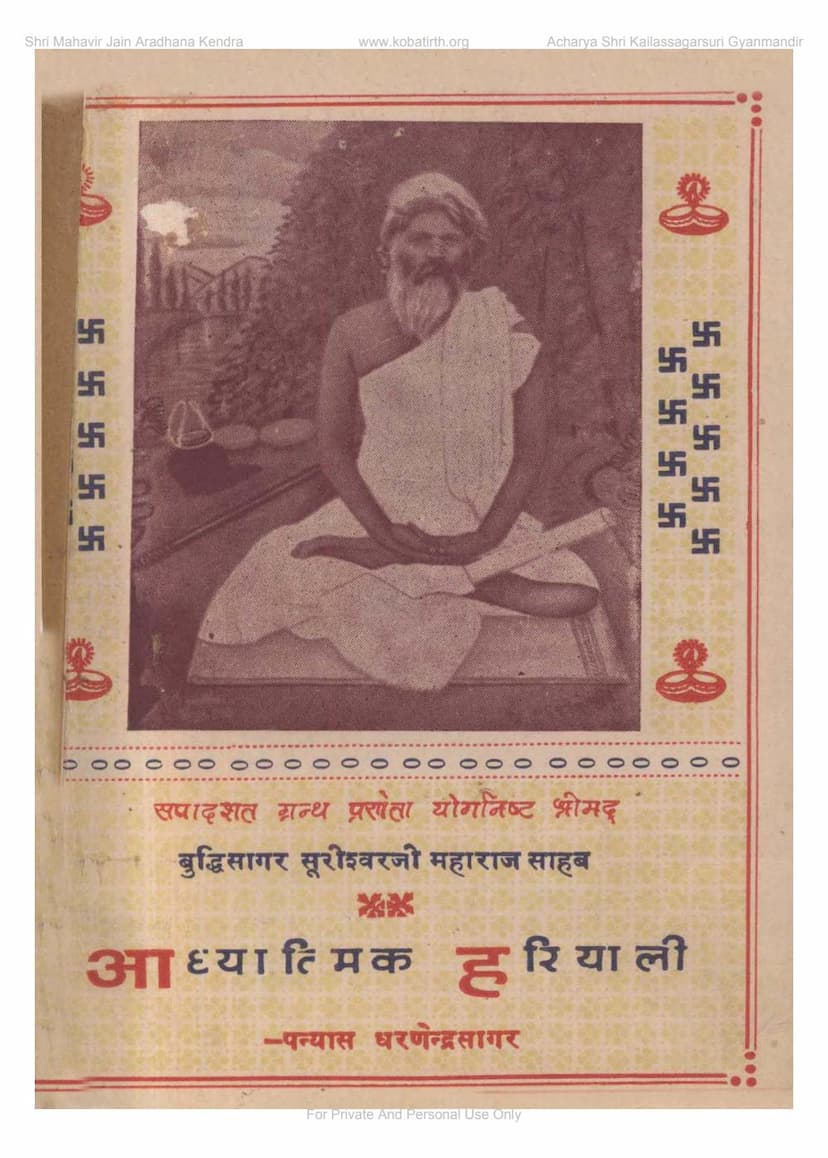Adhyatmik Hariyali
Added to library: September 1, 2025

Summary
This document is the book "Adhyatmik Hariyali" (Spiritual Greenery), compiled and edited by Pt. Dharanendrasagarji Maharaj. Published by Narpatsinh Lodha, it is presented by Shri Mahavir Jain Aradhana Kendra.
The book is a collection of "Hariyali" or "Hiyali" literature, a unique form of riddles or puzzles popular in ancient Gujarati and Rajasthani literature, dating back to the 12th-13th centuries. The core concept of Hariyali is to present a verse that appears contradictory or strange on the surface, but holds a deeper, often spiritual or philosophical meaning. This literary style is also recognized in Sanskrit literature as "Viparyaya Alankar" (figure of speech of inversion).
Key aspects and themes discussed in the introductory sections:
- Nature of Hariyali: It is described as a "serious ocean of literature" where hidden "priceless pearls" of wisdom can be found. It is characterized by its ability to sharpen the intellect, entertain, and serve as a meaningful way to pass time, especially when compared to less constructive activities like playing cards or reading sensational novels.
- Purpose of Hariyali: The primary aim is to engage the reader's intellect in deciphering the hidden meaning. This process not only enhances intellectual capacity but also imparts literary and spiritual knowledge.
- Origin and Terminology: The Gujarati term for this style is "Viprit Vani," "Avval Vani," or "Avali Vani." In Hindi, it can be called "Dviarthatmak Vyang Padya" (double-meaning satirical verse).
- Spiritual Significance: The introduction emphasizes that Hariyali is a form of symbolic language used by yogis for centuries to convey profound spiritual truths in a veiled manner. This is akin to the "Sandha Bhasha" or "Ulat Basiya" of Kabir and other yogis, and the "Koans" in Chinese and Japanese Zen literature.
- Jain Tradition: The text highlights that the Jain tradition also has many such yogis who used this symbolic language, with Anandghanji Maharaj being a prominent figure. His verses are said to be profound, with a worldly appearance but a transcendental meaning. The difficulty in understanding these verses often arises from focusing on the literal words rather than the underlying spiritual secrets.
- The Compiler's Contribution: The book is lauded for bringing together scattered Hariyali literature, translating it into Hindi, and making it accessible to the general public. The editor, Pt. Dharanendrasagarji Maharaj, is commended for his deep study and presentation of this complex literature.
- Notable Authors: The compilation includes works from spiritual luminaries such as Shrimad Anandghanji Maharaj, Upadhyay Shri Yashovijayji Maharaj, Muniresh Shri Vinaysagarji Maharaj, and Muniresh Shri Gyanvijayji Maharaj. Anandghanji Maharaj, in particular, is highlighted for his ability to weave spiritual concepts into the portrayal of a sorrowful woman's state.
- Examples of Hariyali: The introductory sections provide several examples of Hariyali verses, both in Rajasthani and Gujarati, with some translations and explanations to illustrate the concept. These examples often involve paradoxes and seemingly impossible scenarios to convey deeper meanings related to karma, the soul, detachment, and spiritual practices.
- Specific Hariyali Examples and their Interpretation (as seen in the later pages):
- "Sashro Maro Bolo Bholo" (My Father-in-law is Innocent): Interpreted as a depiction of "Trishna" (craving/desire). The father-in-law is identified with "Krodh" (anger), the mother-in-law with "Maya" (delusion), and the husband with the "Jivatma" (soul) in ignorance.
- "Avadhu So Jogi Guru Mera" (That Yogi is my Guru): Explains the nature of the soul and the mind, comparing the soul to a tree without roots or branches, yet bearing the fruit of nectar in the Siddhashila. It also discusses the relationship between the guru (soul) and the disciple (mind).
- Various Hariyali verses by Anandghanji, Sudhan Harsh, Vinay Sagar Muni, Yashovijayji, etc.: These verses present intricate riddles involving seemingly contradictory statements about nature, human behavior, and spiritual states. The interpretations often reveal allegorical meanings related to the soul's journey, the effects of karma, the dangers of attachment, and the path to liberation. For instance, a verse about eight women giving birth to a son and the son increasing the father's might is interpreted as the eight karmic activities giving rise to the cycle of birth and the increase of ignorance. Another verse describes a woman whose husband has gone abroad, but she has children, explained by the father-in-law's innocence and the mother-in-law's childlike nature, leading to the idea of "Bhavitavyata" (destiny) and the soul's interaction with karma.
In essence, "Adhyatmik Hariyali" is presented as a treasure trove of ancient Jain spiritual wisdom, artfully concealed within intricate and thought-provoking riddles. It is a testament to the profound and symbolic nature of spiritual discourse within the Jain tradition, aiming to awaken the reader's intellect and guide them towards spiritual enlightenment.